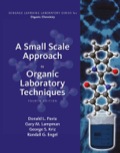
Interpretation:
The reason for 2-bromobutane to react faster than 2-chlorobutane in the test ofsilver nitrate with ethanol and
Concept Introduction:
Answer to Problem 1Q
In 2-bromobutane, -Br is a better leaving group than −Cl therefore it reacts faster than 2-chlorobutane.
Explanation of Solution
Given information:
Both 2-bromobutane and 2-chlorobutane give positive test with silver nitrate with ethanol and KI with acetone.
In 2-bromobutane, -Br is a better leaving group than −Cl therefore it reacts faster than 2-chlorobutane. The −Br leaving group is a weak base therefore it is a good leaving group compare to −Cl which is a stronger base and weak leaving group.
Hence 2-bromobutane reacts faster than 2-chlorobutane with silver nitrate with ethanol and
In 2-bromobutane, -Br is a better leaving group than −Cl therefore it reacts faster than 2-chlorobutane.
Want to see more full solutions like this?
Chapter 19 Solutions
EBK A SMALL SCALE APPROACH TO ORGANIC L
- Which should be more reactive for an SN2 reaction involving sodium iodide in a solution of acetone, 2-chlorobutane or 2-bromobutane?arrow_forwardwhat is the purpose of saturated sodium bicarbonate solution does during the purification of synthesized bromobutane?arrow_forwardwhat would a detailed step-by-step mechanism be for a reaction between bromine and trans-stilbene if the solvent, ethanol, is a stronger nucleophile than the bromide ions?arrow_forward
- why it is not a good idea to use dichloromethane as a solvent in Grignard reactions.arrow_forwardwhat will happen to the reaction of acetone in the sodium nitroprusside Test and in the iodoform test? what will happen if liquid Benzaldehyde is exposed into the air?arrow_forwardWhat would be the product of a reaction involving 2-methyl-2-pentene and HBr both with and without the presence of peroxides?arrow_forward
- Which would be more difficult, extracting propionic acid from water with 1-butanol, or the extraction of propionic acid from 1-butanol with water?arrow_forwardwrite the reaction of the action of methyl-2, bromo-2-propane with hot KOH solution. a) Name the formed product b) Explain why the reaction takes place according to the SNI mechanismarrow_forwardWhat would be the product ratio in the chlorination of propane if all the hydrogens were abstracted at equal rates?arrow_forward
- Write the reaction involved in Ferrox Test. a. What is the species responsible? b. Why is phenol negative in Ferrox Test? Based on the theoretical result, what is the order of reactivity of primary, secondary, and tertiary alcohols in the Lucas Test? a. Lucas Reagent contains ZnCl2 in HCl. What is the role of ZnCl2?arrow_forwardWhich experimental method would you recommend for the preparation of 1-bromooctane and of t-butyl bromide?arrow_forward13. Explain why 92% of 2,4-pentanedione exist as enol in hexane but only 15% of this compound exist as enol tautomer in water?arrow_forward
 EBK A SMALL SCALE APPROACH TO ORGANIC LChemistryISBN:9781305446021Author:LampmanPublisher:CENGAGE LEARNING - CONSIGNMENT
EBK A SMALL SCALE APPROACH TO ORGANIC LChemistryISBN:9781305446021Author:LampmanPublisher:CENGAGE LEARNING - CONSIGNMENT Macroscale and Microscale Organic ExperimentsChemistryISBN:9781305577190Author:Kenneth L. Williamson, Katherine M. MastersPublisher:Brooks Cole
Macroscale and Microscale Organic ExperimentsChemistryISBN:9781305577190Author:Kenneth L. Williamson, Katherine M. MastersPublisher:Brooks Cole

